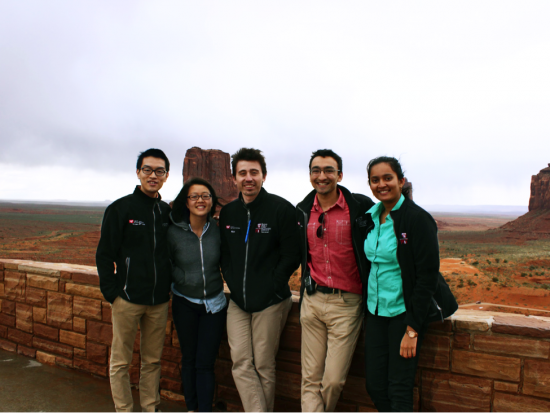
A team of Harvard-MIT Health Sciences and Technology students on a volunteer trip to the Navajo Nation. From left to right: Jeff Meng, Jenny Chen, Manuel Morales, Avilash Cramer, and Aditi Gupta.
A group of us, students from the Harvard-MIT Program in Health Sciences and Technology (HST), were recently offered the opportunity to volunteer with a non-profit organization staffing health screening clinics for preschoolers in Navajo Nation, a semi-autonomous Indian reservation that stretches across Arizona, Utah, and New Mexico. There were five of us in total: three first year and one fifth year MEMP PhD students, and one fourth year MD-PhD student. Our scientific backgrounds ranged from genomic medicine to cardiac imaging to electrical engineering, but we were united by our interest in reducing barriers to health care.
As one might suspect, it was a savvy, hardscrabble, and mildly neurotic group.
WELCOME TO THE WEST
We flew into Flagstaff, Arizona where we were joined by a pediatric ER doctor, the trip organizer, two pre-meds from Akron, Ohio, and one graduate student studying child development in Pittsburgh, Pennsylvania.
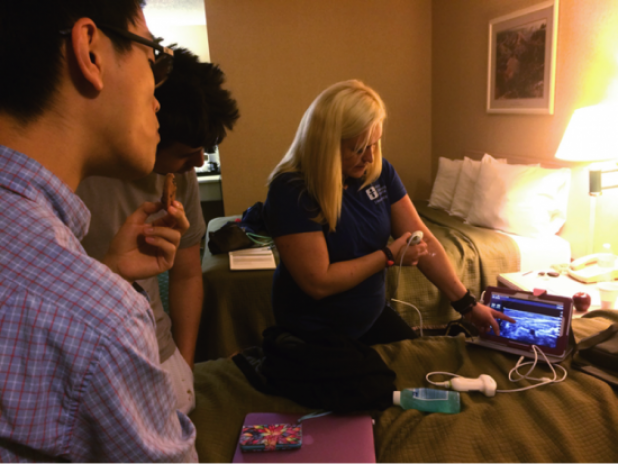
Dr. Danielle Paulin of Akron Children’s Hospital teaches Jeff and Manuel about portable ultrasounds in our motel.
Over the course of three days we traveled over 400 miles and set up a temporary clinic each day throughout the northern Arizona region of Navajo Nation.
-
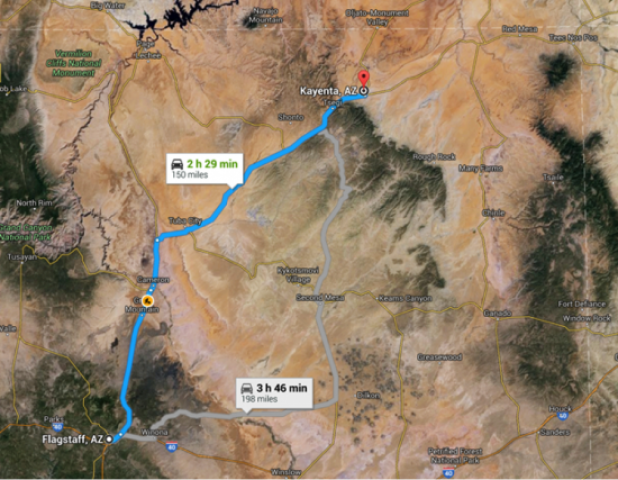
We flew into Flagstaff, AZ and traveled up to the border of Arizona and Utah by car.
- The western half of the Navajo reservation is impressively rural, with hours of driving between municipalities. The reservation is approximately the size of West Virginia, but has about 1/8th as many residents. Were it a state, its population density would be ranked 48th, between that of Montana and Wyoming1, but the western half is even less densely populated. By way of example, this is the town center of Shonto, a small community near the Utah border:
-
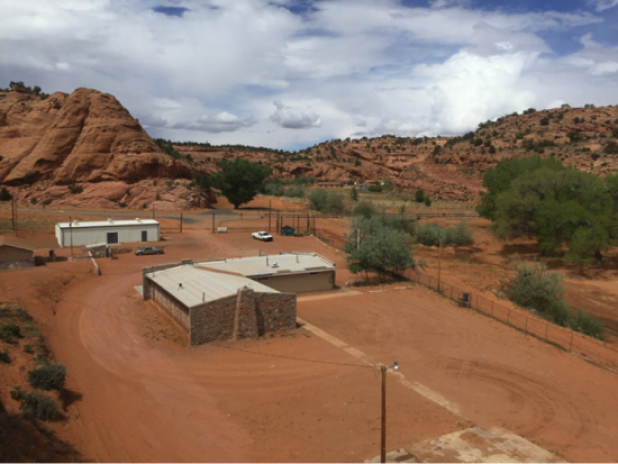
The Navajo Nation is comprised of 110 local entities called “chapters” and each chapter is required to have a Chapter House as an administrative, communal meeting place. Pictured here is Shonto’s Chapter House, where we set up a temporary clinic.
- The Navajo Nation is comprised of 110 local entities called “chapters” and each chapter is required to have a Chapter House as an administrative, communal meeting place. Pictured here is Shonto’s Chapter House, where we set up a temporary clinic.
-
Although desolate and barren, it was a breathtakingly beautiful area. Tuba City is 10 miles from the western edge of the Grand Canyon, and the town of Kayenta was just across the Utah border from Monument Valley, one of the most photographed areas in the United States (and familiar from a handful of John Wayne movies).
-

-
Unfortunately, it was readily apparent that living on the reservation comes with large systemic issues. Within the grandiose beauty of the region were stark reminders that we were travelling through some of the most impoverished and neglected lands in the United States: grocery stores and fresh fruits and vegetables were scarcely available, and there were few food choices beyond Sonic and Taco Bell; PSA posters dotted the communal chapter houses reminding people to avoid eating wild livestock because of possible uranium contamination from drinking groundwater; health care outside of the few major cities within Navajo Nation was non-existent and even the clinics that did exist were overcrowded and chronically understaffed.
Parents of the children we were working with told us stories of spending the entire day at clinics in Window Rock or Tuba City without even getting their blood pressure checked, or of being referred to another clinic or doctor at a different location, hours away. Even more disconcerting, the nearest Level I trauma centers are outside the reservation, in Flagstaff or Albuquerque, which are many hours away, even by helicopter. Bottom line: don’t get into a car accident on the Rez.
THE TRAGEDY OF THE RESERVATIONS
After initial contact with Europeans in the 16th century, disease (especially smallpox) decimated the indigenous population of the Americas. The indigenous populations were further reduced by war and famine, especially with European settlers, and the continued spread (both intentional and unintentional) of disease.
Over the next three centuries, the United States (and other colonial powers) removed and forced most of the Native American tribes onto ‘reserved’ marginal, arid land. Today there are 346 tribal reservations2 designated by the US, the largest of which is the Navajo reservation, located in the southwest.
The list of injustices inflicted upon the Navajo and other native peoples by the US is both long and grim—and we would ask that you turn to a number of other references written by authors far better equipped than us to address the history and current condition of these communities. We would nonetheless like to highlight a couple of important historical features that directly impacted our experiences in medical clinics on the reservation.
The people of the Navajo Nation in particular endured several historical injuries. Collateral damage from mining for a variety of minerals and metals in now-protected areas around the Navajo lands have left scars that will last for decades, if not centuries. One of the most damaging was a scramble for uranium from 1948-1969, which employed thousands of Navajo miners in unsafe working condition without informing them of or protecting them against long-term health risks. In addition to the direct damages to the thousands of miners, who were exposed to radon and other severe carcinogens (and many of whom would go on to develop lung cancer), the Navajo reservation is dotted with over 1,000 abandoned mine shafts, and the mines have severely impacted the waters of the Navajo reservation.
There is a sad irony in that while the military was driving the uranium mining boom (for the production of nuclear weapons in the early days of the Cold War) that was poisoning Navajo lands, Navajo “wind-talkers” in the Army provided critical support and undecipherable communications in the Pacific theater of WWII, as well as the Korean and Vietnam wars.
While the uranium mining tapered off in the later half of the 60s (as documented in appendix A of this 1981 geological report), the damage was done. Today, the uranium and other heavy metal contamination in the groundwater of the Navajo reservation is still so severe that many wells are unusable, even for livestock. And the litany of mining-related environmental disasters has not ceased. As recently as August 2015, the Gold King mine disaster further contaminated the region, requiring many communities to import their water for up to a year. The $456,000 granted to the Navajo Nation by the EPA “for water monitoring” seems a paltry compensation indeed.
-
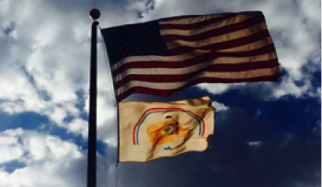
- The Indian Health Service (IHS) was established by the federal government to provide medical care for people living on reservations, but engendered significant distrust by forcibly sterilizing Indian mothers in the 1970s. Although the IHS has improved somewhat in recent years, it remains chronically underfunded, and further compromised by significant cuts during the 2013 government shutdown and sequestration, after which funding was never fully returned. Because of this, access to medical care—even primary and dental care—can be very scarce in many places on the reservations.
-
One common metric of a community’s health is life expectancy. The life expectancy on the reservation—72 years at birth—is close to the global average of 71.4. However, this is significantly lower than the US average of 76.5. Furthermore, American Indians across the country fare much more poorly than the average American by many other metrics of health, including childhood poverty rates, diabetes incidence, substance abuse rates, and adolescent suicides.
SCREENING CLINICS
Our service work was in collaboration with Navajo Nation Head Start, a federally funded public preschool program staffed by Navajo teachers. In order for children to be eligible for enrollment in Head Start, they had to complete medical screenings that covered vision, hearing, development, and a general physical exam. Because traveling to a clinic to complete these screenings could be a multi-day affair for some of these families, we were there to facilitate Head Start enrollment by bringing the clinic to them.
The public meeting houses where we set up our temporary clinics were not ideal places for medical screenings, and we quickly learned the importance of improvisation when working in a rural setting.
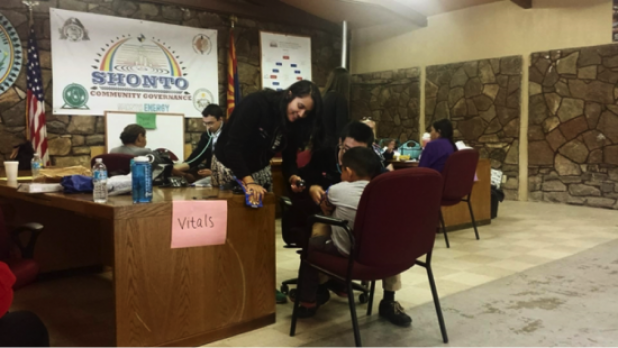
Aditi and Jeff taking vitals on a young patient; in the background Avilash is screening a older community member.
For example, hearing screenings that are usually conducted in quiet, soundproof rooms had to be conducted in a public computer lab and confused computer users were asked to be as quiet as possible.
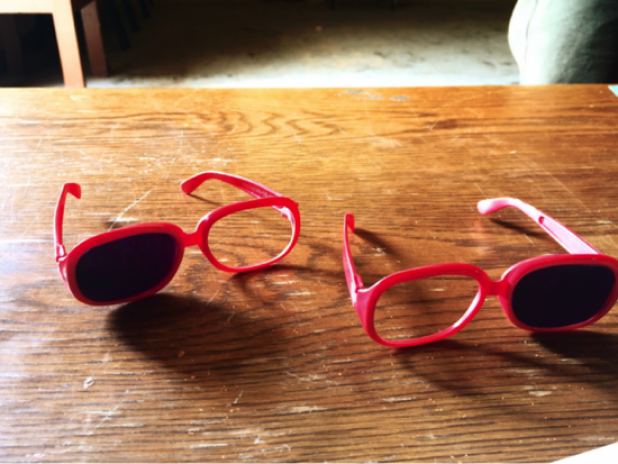
“Patent Pending”
Similarly, the vision and developmental screenings were performed with improvisation. As we found out, it was impossible to ask a 3-year-old child to cover one eye and read from an eye chart without cheating. Thus, we used construction paper and cheap sunglasses from Walmart to make high-tech pediatric occluders:
One challenging question we struggled with was how culture affects childhood development. Each child was screened for developmental delay using a test developed by a British-based education company. Based on these testing criteria, speech delay was prominent in our interactions with the children, but it was very hard to discern if the children were actually incapable of speech, or if they were simply shy and unwilling to talk to strangers.
Every child ended their clinic visit with a physical exam. We recorded vital signs such as blood pressure, temperature, height, and weight for each child and assisted Dr. Paulin with a comprehensive physical exam and blood draw. This station came with the additional onus of collating vials and paperwork while simultaneously corralling wailing toddlers.
The blood draw was to test for hemoglobin and lead levels—two tests federally required for Navajo Head Start to enroll children. Such tests are routinely carried out in places like Boston, where hospitals and supplies are widespread. In the Navajo Nation, however, access is not so simple. The lab in which the samples would be processed was located 425 miles away from our clinics, in Albuquerque, New Mexico. Between the very specific packaging instructions for blood samples (which differ depending on what tests are going to be done), and the time constraints on how long after collection samples can be processed, a simple blood test suddenly becomes a logistical nightmare—the reality of healthcare in rural settings, even within the US.
Despite these issues, we were able to screen over 50 preschoolers in three days, with no small thanks to the wonderful Dr. Paulin and the team from Ohio. It was a fantastic learning opportunity for us as HST students—we practiced basic clinical skills such as taking vital signs and histories; we honed the art of working with children; and we learned to improvise in the face of poorly functioning or limited equipment.

Jeff taking the blood pressure of a five-year-old patient in the Shonto clinic.
All in all, we are proud to have been of service—in some small way—to our patients and their families, and to the communities of Kayenta, Shonto, and Tuba City. We are thankful to IMES and HST for providing the funding for this unique opportunity, and we hope that our experiences highlight one of the many ways MIT students can offer their skills to underserved communities. Finally, we hope that our experiences on the reservation will inform our future endeavors as clinicians and scientists.
1The US recognizes 547 distinct Indian tribes.
2Alaska is 50th. Were it a sovereign nation, the Navajo reservation’s population density would rank between that of Namibia . . . and Mongolia.
About the authors:
Jenny Chen is a fifth-year MEMP student, concentrating in Bioinformatics and Integrative Genomics. Her research is focused on creating algorithms to interpret the genetic code. She hopes these technologies will eventually be used for diagnosis and management of rare genetic diseases.
Manuel Morales is a second-year MEMP student, concentrating in computer science. A former U.S. Navy electrical engineer, his research is focused on developing computational and mathematical models of human physiology using non-invasive imaging tools.
Avilash Cramer is a second-year MEMP student, concentrating in electrical engineering. His research is focused on developing radiography systems for rural and low-income communities.
Aditi Gupta is a second-year MEMP student concentrating in mechanical engineering. Her research focuses on human biomechanics with the aim of developing wearable medical devices to increase access to healthcare in resource-limited settings.
Jeff Meng is a fourth-year MD-PhD student. Currently in the second year of his PhD, he analyzes genomic data from melanoma patients treated with immunotherapy, with the goal of predicting patient response and developing better therapies.
POST SCRIPT: FUN WITH TIME ZONES
Fun fact: Arizona does not observe daylight savings time, even though the rest of the nation does. The Navajo nation encompasses territory in the states of Arizona, New Mexico, and Utah. However, the capital, Window Rock, is located in New Mexico, so the entire Navajo nation is on New Mexico time (Mountain Daylight Time, MDT)—including the part located in Arizona.
Now, the Navajo nation encircles the Hopi nation, another Indian reservation. However, the Hopi nation falls entirely within Arizona, so the Hopi nation is on Arizona (Mountain Standard Time, or MST). So, driving west from Flagstaff, the time zone will start in MST, switch to MDT, switch back to MST, and then switch again to MDT.
Tuba City is on the border of the Navajo and Hopi reservations, so in Tuba City the time literally depends on what side of the main street you are on.
Further confusing the matter was the fact the most of the hotels in Cameron, Arizona—a one stoplight town just inside the Navajo county border—keeps their clocks on Arizona time in defiance of county lines as a courtesy to tourists coming from Flagstaff and other points west. Unfortunately, cell phones in Cameron will usually pick up service from a tower within the Rez, so cell phones will display a different time than the clocks. Anyways . . . we were only an hour late a couple of times.
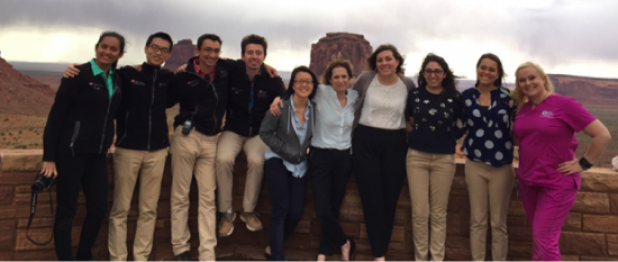
The full crew.
Authors: Jenny Chen, Manuel Morales, Avilash Cramer, Aditi Gupta, Jeff Meng